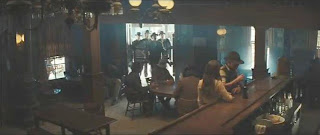 Friday, December 30, 2011
Friday, December 30, 2011I’ve always liked riding the rails, even if it always takes me twice as long to get where I’m going than it would if I drove.
My disability simply lets me indulge these days, though I still bump into things I can’t see along my right side, the patch over that eye blanking out that whole side of my world.
The ride from the 9th Street elevator takes me through the back normally unseen places of a once industrial world, showing the encroachment of so called civilization as developers scramble to rebuild this ancient part of the planet into something more appealing to the up and coming generations whose parents had abandoned this place years ago for the suburbs.
With the poor driven out by fire or imprisonment, these streets are once again safe for the sheep-like law-abiding masses who are content to live their lives out in blind repetition, doing those things proscribed by society such as giving birth, paying taxes and dying.
But watching the old world pass always makes me sad. This place meant something back when working people lived here, it was the foundation of hopes and dreams that the new generations has taken advantage of without the same sacrifice, every inch of the cracked concrete below the rail bridge drenched in the sweat of hard-working immigrants who started life over in these crowded streets only to get crowded out when these streets became desirable for this new way of life.
I sat on the opposite side of the train this time than I usually do, and so a similar landscape on the far side, despite my bad eye, but now, set against the backdrop of the New York Skyline and the monstrously egotistic Port Authority project misnamed “Freedom Tower,” like one very large middle finger exposed against the rest of the world and the terrorists who had deflated the American ego with their attacks on Sept. 11, 2001.
The Port Authority has to rebuilt it, even if they have to raise the tolls on every bridge and every Path ride to do it, proving with their continue arrogance that America is still the best place in the world to live – at least for some.
At the same time, we have the overinflated ego of the overrated mail clerk who became Mayor of New York setting up armed guards around the large bronze bull near Wall Street on the off chance that someone might attempt to befoul the poor creature with appropriate mockery – putting to shame the ultimate egotistic stupidity of greed which New York City has become, where vendors who used to charge a dollar a bag for chestnuts this time of year now have to charge five because of the heavy fees the city has imposed on them for them to do business.
Mayor Bloomberg even celebrated the fact that New York City has become the national center for tourism, and he can since he doesn’t have to put up with the pushing and shoving ordinary people have to endure just trying to live there with so many rude tourists.
Bloomberg and the mayors before him have made it impossible for poor and honest people to live in New York. He’s even offered to pay the plane fares for homeless to leave. New York like America is only free if you can afford the price of living here, and you are part of the food chain from which business people and government feeds, picking the pockets of working people at each turn.
If you don’t pay taxes, if you don’t hand out the contents of your wallet to over priced vendors, then you do not have a right to live here.
Even in the days of Walden Pond, it was only possible to live free if you like that author, had an inheritance to fall back on.
Try setting up a tent in a park and see how fast the air fills with pepper spray.
















































